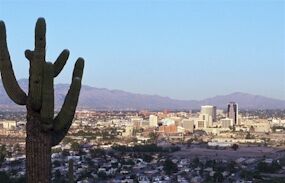
Light Rail Progress can be contacted at: Light Rail Progress |
Note: Tucson's light rail/mobility plan, referred to in this commentary, was defeated by voters on 4 November 2003.
For more details, see Nov. 4th Election Result: Major Net Victory for US Rail Transit.
As we note in our article Tucson: Grassroots Campaign Sparks Nov. 4th Vote on Light Rail + Other Mobility Options, Tucson, Arizona voters will face a choice on 4 November 2003: Stay with
the current system of de facto dependency on the automobile, and all the
associated traffic headaches and cost burdens ... or vote for Propositions
200 and 201 to commit Tucson to an alternative mobility system of light
rail transit (LRT), dramatic bus service improvements, pedestrian and
bicycle infrastructural upgrades, and other ambitious measures to provide
Tucsonans more and better options in how they get around the city. This alternative mobility system, as our article points out, includes
a 13-mile of LRT starter system, 47 miles of Quality Bus ("Bus
Rapid Transit") service, plus an extensive high-quality express
and limited-stop bus system – a vast upgrade of Tucson's existing
transit system – reaching throughout the Tucson metro area.
Amazingly, this ambitious plan has been the brainstorm, not of the
city's top planners and decisionmakers, but of a grassroots
movement called Citizens for a Sensible Transportation Solution
(CFASTS), lacking the united support of the city's top echelons. Nevertheless, support for the plan has been forthcoming from
some farsighted public figures. One of these is Arizona Republic
columnist Jon Talton, whose column endorsing the CFASTS
proposal was recently carried in the Tucson Citizen (which also endorses the plan). http://www.tucsoncitizen.com/index.php?page=opinion&story_id=103103b4_lightrail Tucson Citizen Tucson should break free, vote for light rail Jon Talton PHOENIX – A persistent cocktail-party conversation among old Arizonans begins, "What happened to Tucson?" The Old Pueblo's citizens were reputed to be more educated and progressive than we rubes up the interstate. But instead of becoming the Portland of the Sonoran Desert, Tucson turned into a smaller version of hated Phoenix, without freeways. It even has a respected Republican mayor.
Tucson voters have a chance to start digging out of this hole Tuesday if they pass a comprehensive transportation plan that pits the grass roots against the most powerful business interests. The plan would use relatively modest sales and construction tax increases to raise $50.5 million a year for 20 years, by adding 3 cents to a $10 purchase and $3,900 to the price of a $150,000 house.
This sensible, visionary proposal would be a major economic plus, an amenity sought by knowledge workers and companies. It would boost a city that is already smaller, cooler and set in a more beautiful locale than Phoenix. It's not a regional plan, but that wasn't going to happen. Tucson transportation has been hobbled for decades by demands for perfection. It has also been hurt by a stalemate between a majority of citizens and the freeway lobby. The former keeps defeating freeway plans. The latter keeps sabotaging alternatives. This time, three elements are in the mix: · Developers, builders and car dealers who are dead-set against anything that might halt unlimited sprawl. They have the money in this fight and have used their power to seed business opposition. As opposed to the experience in Phoenix, the Tucson Metropolitan Chamber of Commerce is against the plan. · People who lack experience in cities with good transit systems. These include many longtime Arizonans, transplants from smaller spots in the Midwest, and disengaged retirees. They are susceptible to every myth and lie of anti-transit forces. · Citizens who are ready for a change. These include thousands who signed petitions supporting the plan, newcomers who understand the need for transportation options, progressive business people, and many who are just sick of the gridlocked status quo. The problem with the "anti" argument is that it offers nothing but more of the same, only worse. Outside the bubble of Arizona isolation, cities across America are building balanced transportation systems. Developers and car dealers in these cities do quite well. It's all about choices. Freeways can be a good piece of a transportation system that also includes buses, rail and other modes. Alone, freeways cause substantial environmental and neighborhood damage. But for decades they have mustered one of history's most powerful lobbies. Can Tucson voters break that death grip? if so, the cocktail talk will be about the city finally aiming for its world-class potential. Jon Talton is a columnist for The Arizona Republic. E-mail: jon.talton@arizonarepublic.com. Light Rail Now! websiteUpdated 2003/11/04 |
|
|
|